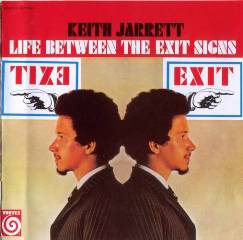Keith Jarrett - Life Between The Exit Signs (1968)
Keith Jarrett - Life Between The Exit Signs (1968)

A1 Lisbon Stomp 6:02 A2 Love No. 1 6:11 A3 Love No. 2 4:27 A4 Everything I Love 4:30 B1 Margot 3:43 B2 Long Time Gone (But Not Withdrawn) 4:51 B3 Life Between The Exit Signs 6:48 B4 Church Dreams 6:15 Keith Jarrett (piano) Charlie Haden (bass) Paul Motian (drums)
Not long after recording '66's Buttercorn Lady with Art Blakey, and Dream Weaver , which signalled the beginning of his association with Charles Lloyd's hugely popular quartet, pianist Keith Jarrett was encouraged by Lloyd producer George Avakian to make his first recording as a leader. Jarrett's immediate popularity in Downbeat 's Readers poll for that year was instrumental in his being able to attain complete artistic freedom, a characteristic that has ultimately defined his entire career. Life Between the Exit Signs finds a nascent Jarrett wearing some of his primary influences on his sleeve—Bill Evans, Paul Bley and Ornette Coleman most notably—but, even so, many of his defining qualities as a distinctive player are already in evidence.
Beginning an association with bassist Charlie Haden and drummer Paul Motian that was to last for nearly ten years, Jarrett demonstrates a penchant for overt lyricism on "Margot" and "Love No. 1," a somehow distinctly American flavour on "Lisbon Stomp," and free playing on the title track and "Love No. 2," which follow the Ornette Coleman modus operandi of structured themes leading into completely open improvised sections. He even covers one standard, Cole Porter's "Everything I Love," to show his love of the Great American Songbook, a characteristic that would, of course, be brought to greater fruition with his now twenty-year old Standards Trio with Gary Peacock and Jack DeJohnette.
Haden, having already spent a good deal of time with Coleman, brings a strong sense of adventure coupled with a clear sense of history and tradition. Motian, at that time better known for his more subdued work with Bill Evans, gets the opportunity to play in a looser setting, displaying his abilities as textural player and colourist that would gain him a greater reputation in years to come.
But as strong as Haden and Motian are as musical personalities, it is Jarrett who clearly shines on this recording. Less concerned with some of the more odd choices that he made in the mammoth '70 session that resulted in three intriguing but largely uneven recordings— The Mourning of a Star, El Juicio and Birth —this is a more straightforward session that, while perhaps less widely experimental, ultimately succeeds as a more consistent document of where Jarrett came from and who he was ultimately to become. Life Between the Exit Signs is a remarkable first outing from a pianist who has inarguably become as important as his sources, moving the tradition forward while at the same time maintaining a clear reverence for it. ---John Kelman, allaboutjazz.com
download (mp3 @320 kbs):
yandex 4shared mega mediafire zalivalka cloudmailru oboom uplea
